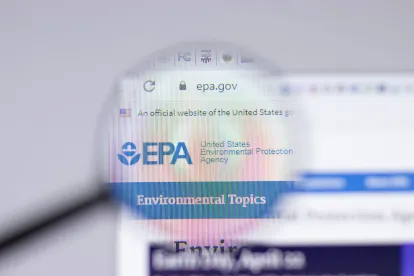How the US Environmental Protection Agency (EPA) will factor environmental justice (EJ) principles into permitting decisions remained largely an open question throughout 2022. In the waning days of the year, EPA’s Office of Air and Radiation’s guidance engages with the question without providing definitive procedures.
The guidance, available here, was issued as an attachment to an attachment to a memorandum from Joseph Goffman of the Office of Air and Radiation to all Air and Radiation Division directors on December 22. The guidance purports to provide “best practices” including “early identification of potential environmental justice concerns” and “ongoing engagement with communities throughout the permitting process.” EJ analysis, says the memorandum, must be determined on a “case-by-case basis” and opportunities for addressing “disproportionately high and adverse effects” associated with permitting may also vary situationally, as would the tools for addressing them, which include local, state, and federal laws.
What’s in the Guidance
The attachment itself notes that it builds upon EPA’s Interim Environmental Justice and Civil Rights in Permitting Frequently Asked Questions (EJ Permitting FAQs), discussed here, and that it provides a framework of principles and practices to assist each EPA region in promoting environmental justice and equity through air permitting programs using existing [Clean Air Act (CAA)] authorities and discretion, federal civil rights laws, as well as other federal and state laws that may help to mitigate potential adverse and disproportionate effects of a permitting action.
Framework principles in the guidance include:
-
Identify communities with potential environmental justice concerns.
-
Engage early in the permitting process to promote meaningful participation and fair treatment.
-
Enhance public involvement throughout the permitting process.
-
Conduct a “fit for purpose” environmental justice analysis.
-
Minimize and mitigate disproportionately high and adverse effects associated with the permit action to promote fair treatment.
-
Provide federal support throughout the air permitting process.
-
Enhance transparency throughout the air permitting process; and
-
Build capacity to enhance the consideration of environmental justice in the air permitting process.
No concept in this framework is new and most were previously discussed in both EPA’s EJ Permitting FAQs and EPA’s Equity Action Plan, discussed here.
The guidance expressly disclaims having any substantive legal effects:
This document does not change or substitute for any requirement under the CAA or its implementing regulations, any EPA-approved CAA permitting program, or Title VI of the Civil Rights Act, nor are they a regulation themselves. Nothing in this document is intended to impose or establish legally binding requirements, and no part of this document has legally binding effect or represents the consummation of agency decision making. To the extent there is any inconsistency between this document and any statute, regulation, or guidance, the latter takes precedence. EPA retains discretion to use or deviate from this document as appropriate. It is, therefore, not a final agency action and is not judicially reviewable. (Emphasis added.)
Issues to Watch
Practically speaking, nothing in the guidance is truly new. We previously outlined practical steps entities can take to minimize permitting challenges in EJ communities, and these steps continue to be appropriate.
Three principles set forth in the guidance — EPA’s focus on community “capacity building,” “disproportionately high and adverse effects,” and “‘fit for purpose’” EJ analysis — are worth further discussion, as three are harbingers of potential future challenges for the regulated community. Finally, we will discuss the meaning of the guidance’s declaration that it is “not a final action.”
Capacity Building
The Biden Administration’s focus on capacity building in the EJ space is based on the supposition that past governmental decision making “contributed to the disproportionate pollution burden on people of color and underserved communities across the country” and acknowledges that these same mistakes likely would continue without meaningful community participation.” The Biden Administration has sought to address this issue by focusing to a greater degree on public participation in EJ communities but also by working through funding community-led environmental projects. (See our discussion of Inflation Reduction Act related EJ spending here.)
Federal efforts to build capacity are occurring in parallel with private efforts to empower community groups. In September, the Bloomberg Philanthropies announced a new $85 million campaign entitled “Beyond Petrochemicals: People Over Pollution,” building on past efforts to get “beyond coal” and “beyond carbon.” Some groups funded by this campaign are among those spearheading recent EJ-focused challenges to industrial plants in Louisiana, where EPA has sought to leverage its civil rights powers. (See our past discussion here.)
“Fit for Purpose” EJ Analysis and “Disproportionately High and Adverse Effects”
EPA’s “fit for purpose” EJ analysis is a Trojan horse camouflaging EPA’s ambitious EJ goals, which are better illustrated by EPA’s actions preceding the guidance:
-
EPA has pushed for dramatic changes in state-level permitting in Louisiana on EJ grounds and suggested that a prospective permittee pay to relocate an elementary school as a condition of receiving a permit. (See our discussion here.)
-
In Chicago, the Biden Administration threatened Chicago’s future funding from the US Department of Housing and Urban Development in an effort to forestall the relocation of a Chicago metal recycling facility into an EJ area. (See our discussion here.)
The guidance’s call for a “fit for purpose” EJ analysis includes a variety of procedural and substantive factors that can be viewed ranging from the unobjectionable, i.e., “further analysis of demographic data,” further input from the affected community, and “[a]n evaluation of the facility’s compliance record” to the transformative, i.e., “evaluation of the cumulative impact of the permitting action . . . together with impacts from other regulated and non-regulated sources of pollution in the community” and evaluation of “potential effects” of permitting action “on the health of a population and the distribution of those effects within the population.” These more transformative factors — evaluating “cumulative impacts” and potential effects on demographic groups subsumed in an EJ community — include analyses similar to those being considered in New Jersey, New York, and Massachusetts.
“Not a Final Action”
A final issue to discuss is the guidance’s declaration that it is not “final agency action.” EPA likely declared that this is “not a final agency action” for two separate reasons: first, because the guidance presents itself as a sort of compendium of possible resources which can be used to facilitate a site-specific EJ permitting analyses; and second, because regulatory actions which are not “final” cannot be challenged under the federal Administrative Procedure Act. This second factor mirrors the Biden Administration’s efforts to preclude review of the tools like its “social cost of carbon” metric (see our discussion here), which can have significant effects on policy without being reviewable by a court.




 />i
/>i

